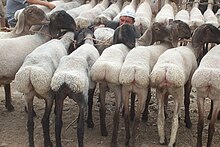利用者:Yo stechpalme/脂尾羊

The fat-tailed sheep is a general type of domestic sheep known for their distinctive large tails and hindquarters. Fat-tailed sheep breeds comprise approximately 25% of the world's sheep population,[1] and are commonly found in northern parts of Africa, the Middle East, Pakistan, Afghanistan, Iran, North India, Western China, Somalia[2]and Central Asia.[3]
Two general varieties of fat-tails exist, the broad fat-tails and the long fat-tails. The majority of fat-tailed sheep breeds have broad fat-tails, where the fat is accumulated in baggy deposits in the hind parts of a sheep on both sides of its tail and on the first 3–5 vertebrae of the tail.[4][5] In the long-tailed sheep the fat is accumulated in the tail itself, which may grow so large that it drags on the ground and hinders copulation.[4]
The earliest record of fat-tailed sheep is found in ancient Uruk (3000 BC) and Ur (2400 BC) on stone vessels and mosaics. Another early reference is found in the Bible (Exodus 29:22 and Leviticus 3:9), where a sacrificial offering is described which includes the tail fat (called Alya, Hebrew: אַלְיָה) of sheep.
Sheep were specifically bred for the unique quality of the fat stored in the tail area and the fat (called alyah, Arabic:[6] ألية) was used extensively in medieval Arab and Persian cookery. The tail fat is still used in modern cookery, though there has been a reported decline, with other types of fat and oils having increased in popularity. The name of the star Alioth comes from the same Arabic word.



Fat-tailed sheep are hardy and adaptable, able to withstand the tough challenges of desert life. When feed is plentiful and parasites not a major factor, fat-tailed sheep can be large in size and growth. The carcass quality of these sheep is quite good, with most of the fat concentrated in the tail area - it could account for as much as 10 pounds (4.5 kilograms) of the weight on a 60 pound (27 kilogram) carcass.[要出典] The fat-tailed breeds seen frequently in the US are the Karakul and Tunis.[要出典]
The wool from fat-tailed breeds is usually coarse and frequently has colored fibers. It would be of limited value in commercial markets. Today it is used primarily for rug-making and other cottage-type industries. Bedouin women make rugs and blankets from the wool. Some of their handiwork can be purchased in the villages of Egypt. Shearing in Egypt is done once or twice a year with hand clippers. There is a reluctance to use electric shears because of wool quality and the difficulty in getting replacement parts when they become dull or worn out.[要出典]
Breeds
[編集]- Adal sheep
- Afghan Arabi
- Afrikaner
- Alai sheep
- Altay sheep
- Armenian Semicoarsewool
- Awassi
- Balkhi
- Blackhead Persian
- Chios
- Damara
- Edilbay sheep
- Karakul
- Laticauda
- Meatmaster
- Mongolian breeds: Khalkh, Baidrag etc.[7][8]
- Pedi
- Red Maasai
- Somali sheep
- Tunis
- Tunisian Barbarin
- Van Rooy sheep
- Zulu, or Nguni
References
[編集]- ^ Davidson, Alan (1999). Oxford Companion to Food. Oxford: Oxford University Press. pp. 290–293. ISBN 978-0-19-211579-9
- ^ Rigby, C. P (1867). “On the Origin of the Somali Race, Which Inhabits the North-Eastern Portion of Africa”. Transactions of the Ethnological Society of London 5: 91–95. doi:10.2307/3014215. JSTOR 3014215.
- ^ Reay Tannahill, 1973, Food in History p. 62 and 176. ISBN 0-8128-1437-1
- ^ a b Jill Tilsley-Benham (1987): “Sheep with Two Tails: Sheep's Tail-Fat as Cooking Medium in the Middle East.” (Pages 47–48, see google books) In: Tom Jaine (ed.), The Cooking Medium, proceedings of the Oxford Symposium on Food and Cookery 1986, London, Prospect Books 1987. ISBN 090732536X. Retrieved 13 October 2017
- ^ Template:Cite Efron
- ^ Team, Almaany. “ترجمة و معنى ألية بالإنجليزي في قاموس المعاني. قاموس عربي انجليزي مصطلحات صفحة 1”. www.almaany.com. Template:Cite webの呼び出しエラー:引数 accessdate は必須です。
- ^ “Sheep breeds of Mongolia”. www.fao.org. Template:Cite webの呼び出しエラー:引数 accessdate は必須です。
- ^ https://mofa.gov.mn/livestock/index.php?option=com_content&view=category&layout=blog&id=48&Itemid=72&lang=en
External link
[編集] ウィキメディア・コモンズには、Yo stechpalme/脂尾羊に関するカテゴリがあります。
ウィキメディア・コモンズには、Yo stechpalme/脂尾羊に関するカテゴリがあります。

脂尾羊(しびよう)は巨大な尾と臀部を特徴とする羊の一種である。世界で飼育される羊の約25%を占めており[1]特に北アフリカ、中東、パキスタン、アフガニスタン、イラン、インド北部、中国西部、ソマリア[2]、中央アジア [3]等で一般的である。
脂尾羊は、尾の幅が広い種と尾の長さが長い種に大別される。そのうちの大部分は尾の幅が広い脂肪尾を持つ種であり、尾の両脇に当たる臀部や椎骨の先端3~5個の辺りに膨らんだ塊として脂肪が蓄積される。 [4] 尾の長さが長いでは、脂肪が尾自体に蓄積され、大きくなりすぎて地面を引きずり、交尾を妨げる可能性があります。
ファットテールの羊の最古の記録は、古代に発見されたウルク( 3000 BC )とウル( 2400 BC石船や上)モザイク。別の初期の参考文献は聖書(出エジプト記29:22とレビ記3:9)にあり、羊の尾脂肪(アリア、ヘブライ語:אַלְיָהと呼ばれる)を含むいけにえのささげ物が説明されています。
羊は、具体的には、アラビア語alyahと呼ばれるテールエリアと脂肪(に保存されている脂肪のユニークな品質のために飼育された: [5] ألية )中世のアラブ料理とペルシャ料理で広く使用されていました。テールファットは現在でも現代の料理で使用されていますが、他の種類の油脂の人気が高まっていることから、減少が報告されています。星Aliothの名前は、同じアラビア語に由来しています。



脂尾羊は丈夫で順応性があり、砂漠での困難な課題に耐えることができます。飼料が豊富で寄生虫が主要な要因ではない場合、脂尾羊はサイズと成長が大きくなる可能性があります。これらの羊の枝肉の品質は非常に良好で、脂肪の大部分は尾部に集中しています。60ポンド(27キログラム)の枝肉の重量の10ポンド(4.5キログラム)を占める可能性があります。[要出典]米国で頻繁に見られる太った尾の品種は、カラクールとチュニスです。[要出典]
太い尾の品種からの羊毛は通常粗く、しばしば着色された繊維を持っています。商業市場では価値が限られています。今日では、主にラグ製造やその他のコテージタイプの産業に使用されています。ベドウィンの女性は羊毛から絨毯や毛布を作ります。彼らの手仕事のいくつかはエジプトの村で購入することができます。エジプトでの毛刈りは、年に1〜2回バリカンで行われます。羊毛の品質と、くすんだり磨耗したりしたときに交換部品を入手するのが難しいため、電気剪断機の使用には消極的です。[要出典]
品種
[編集]参考文献
[編集]
外部リンク
[編集] ウィキメディア・コモンズには、Yo stechpalme/脂尾羊に関するカテゴリがあります。
ウィキメディア・コモンズには、Yo stechpalme/脂尾羊に関するカテゴリがあります。
- ^ Davidson, Alan (1999). Oxford Companion to Food. Oxford: Oxford University Press. pp. 290–293. ISBN 978-0-19-211579-9
- ^ Rigby, C. P (1867). “On the Origin of the Somali Race, Which Inhabits the North-Eastern Portion of Africa”. Transactions of the Ethnological Society of London 5: 91–95. doi:10.2307/3014215. JSTOR 3014215.
- ^ Reay Tannahill, 1973, Food in History p. 62 and 176. ISBN 0-8128-1437-1
- ^ 引用エラー: 無効な
<ref>タグです。「OxSympFoodCook 1986」という名前の注釈に対するテキストが指定されていません - ^ Team. “ترجمة و معنى ألية بالإنجليزي في قاموس المعاني. قاموس عربي انجليزي مصطلحات صفحة 1”. www.almaany.com. Template:Cite webの呼び出しエラー:引数 accessdate は必須です。
